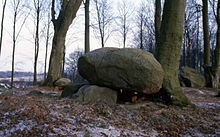Pipstorn
The Pipstorn is a forest on the Danish island of Funen , which is near the town of Fåborg on both sides of the railway line to Svendborg . In the forest there are grave and cult sites that have been used for thousands of years. The dolmens date from the Neolithic Age around 3500–2800 BC. And are megalithic systems of the funnel beaker culture (TBK). Neolithic monuments are an expression of the culture and ideology of Neolithic societies. Their origin and function are considered to be the hallmarks of social development.
Monuments
- Dolmens in round and long hills
- miscellaneous old barrows ( Danish højgrave or tuegrave )
- a stone circle
- Stone boxes
- Vorzeitäcker ( Wölbäcker )
The Pipstorn has belonged to Findstrupgaard, the later manor Holstenshus, since ancient times. The remains of old fields show that parts of the forest were arable land. However, the limited floor structure meant that a varied selection of objects from the past was preserved.
Dolmen
The five preserved long graves are the oldest known graves in the forest. Some of the small dolmens lie in barren beds and were built between 3500 and 2800 BC. So it was laid out during 700 years of the Neolithic period , but was sometimes used for thousands of years. In the Pipstorn you could see a beech tree until 1999 , the roots of which were entwining around a stone grave. This tree fell over in a storm.
Great burial mounds
The 34 large burial mounds in Pipstorn are the largest concentration of burial mounds on Fyn / Langeland . The hills have not been examined, but date from the older Bronze Age (1800–1000 BC). The larger ones were later used to bury urns or tree coffins .
Small burial mounds
The small barrows date from the younger Bronze Age (1000–500 BC) and the older Iron Age . The burial mound was created over several centuries during the time of the cremation. Another group of small barrows is surrounded by a barely visible stone circle . They contain cremation graves from the pre-Roman Iron Age, the centuries before the turn of the times.
Stone circle
Twenty large stones are arranged in a circle on a hill between the barrows. The complex resembles the graves of the late Iron Age such as Lindholm Høje with stone circles around cremation graves. Such stone settings can also be oval, square, triangular or ship-shaped. They were created around 500–1000 AD.
Stone boxes
A watercourse goes under the path between finely crafted coffins made of hewn field stones. These stone boxes can be several hundred years old.
Völbäcker
Hill-shaped fields as long, narrow elevations can be seen in five places in the forest. The form of the field was created by plowing the earth towards the middle of the field. The depressions between the fields acted as drainage ditches. The method was used from the Middle Ages to the 18th century. The fields in Pipstorn are unusually narrow with a width of five meters.
See also
literature
- Ingrid Falktoft Andersen: Vejviser til Danmarks oldtid. 2nd Edition. Gads Forlag, Århus 1994, ISBN 87-89531-10-8 .
- Karsten Kjer Michaelsen: Politics bog om Danmarks oldtid . Copenhagen 2002 ISBN 87-567-6458-8 , p. 156
Individual evidence
- ^ Johannes Müller : Neolithic Monuments and Neolithic Societies. In: Hans-Jürgen Beier , Erich Claßen, Thomas Doppler, Britta Ramminger (eds.): Varia neolithica VI. Neolithic Monuments and Neolithic Societies. Contributions from the meeting of the Neolithic Working Group during the annual meeting of the North-West German Association for Ancient Research in Schleswig, 9. – 10. October 2007 (= contributions to the prehistory and early history of Central Europe. Vol. 56). Beier & Beran, Langenweißbach 2009, ISBN 978-3-941171-28-2 , pp. 7-16, here p. 15.
Web links
- Description and map of Pipstorn Skov (PDF, 234 kB)
- Description Danish
- Video
Coordinates: 55 ° 5 ′ 9.5 ″ N , 10 ° 17 ′ 34.3 ″ E


